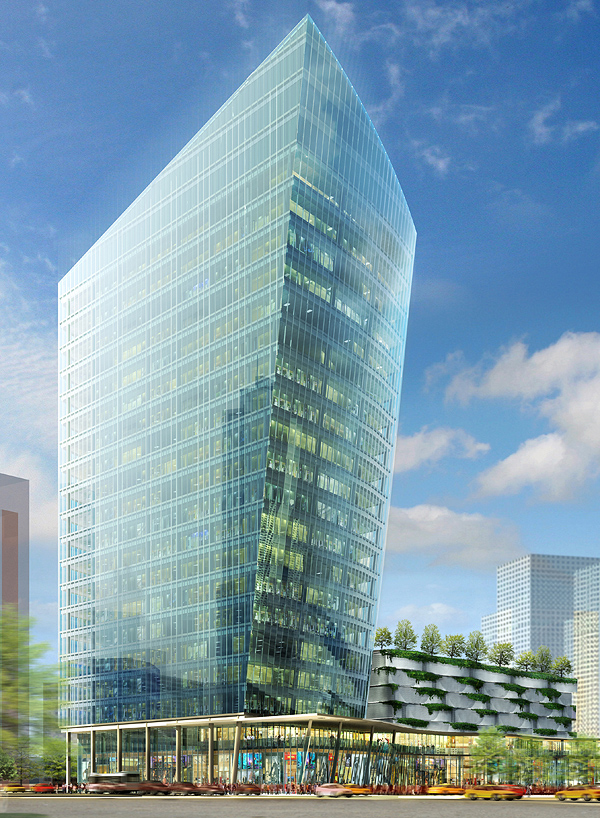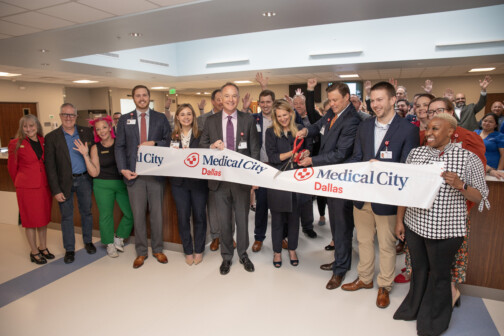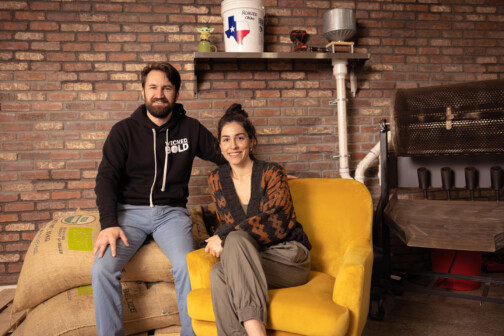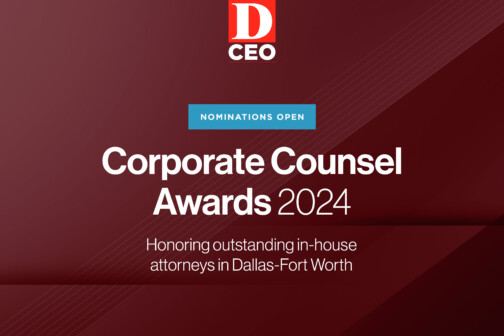Perhaps nowhere will the impact of Klyde Warren Park be felt more than in the Uptown and downtown Dallas real estate markets. Surrounding properties that once had to contend with a busy, noisy freeway will now overlook a lush, 5.2-acre greenscape.
Some developers didn’t wait for the park to open; the city’s $20 million bond approval for the project in 2006 was the only green light they needed.
Among the properties sprouting up since then are 2000 McKinney, a 442,355-square-foot, 14-story tower co-developed in 2008 by Lincoln Property Co. and Corrigan Properties Inc.; and Museum Tower, a 42-story luxury condominium project in the Arts District.
The mixed-use 2000 McKinney, also known as the Texas Capital Bank building, is nearly fully leased. Finish-out work will begin soon on its 15 condominium units that overlook the park. It’s also getting a new parkside eatery, LARK, a concept from restaurateur Shannon Wynne.
And Museum Tower, although mired in an “excessive glare” controversy (the Nasher Sculpture Center contends that the the sun’s reflection off the condo tower’s glass exterior is destroying its outside garden and compromising its galleries inside), is expected to fill as construction is finished and the economy bounces back.
“The park is an enormous economic development opportunity—unlike any we’ve seen in a long time,” says John Crawford, president and CEO of Downtown Dallas Inc. “Within a quarter-mile to a half-mile radius, since we’ve started talking about the park, we’ve seen well over $1 billion in new projects, both residential and commercial. A lot of people were betting that the park would become a reality, and it has.”
Klyde Warren Park, says Crawford, “rights a lot of wrongs.” A new highway system was necessary to provide traffic circulation, but Woodall Rodgers Freeway, in effect, isolated the CBD. The park removes that barrier and “gives us a much bigger sandbox to play in. It will help provide the type of urban environment that companies and people are hungry for today.”
Carl Ewert, managing director at Jones Lang LaSalle, has long focused on the downtown and Uptown markets. He represented Comerica Bank in its headquarters relocation to Dallas from Detroit in 2007, among other big-name clients. He says tenants will pay to be near Klyde Warren Park.
“Places that overlook a park are rare,” he says. “Different people will want different views. Some tenants will want higher-level floors, where they can look down at the park but also look out at downtown Dallas or Uptown. Others will want to be closer to the action.
“Typically in office buildings, users want the view corridor on the higher floors,” says Ewert. “But for properties with proximity to the park, that lower-level space becomes premium, too.”
One low-rise project that’s ripe for redevelopment is 1909 Woodall Rodgers Freeway. The five-story, 76,000-square-foot office building is owned by Miyama USA Texas LP, which also owns an adjacent drive-thru bank location leased by Dallas Credit Union. Both properties sit on about 1-acre sites, says Sawako Miyama, who is overseeing Dallas investments for her Japanese family.
Miyama’s father acquired the parkside properties in 2006, after selling The Shelton, a luxury Preston Center residential community the family had owned and operated for more than 20 years. The Miyamas also have industrial and multifamily investments in Dallas.
Along with abundant parking, 1909 Woodall Rodgers Freeway offers stunning, up-close views of the park. The property, which is being renamed Miyama Parkside, is 95 percent occupied, and existing tenants continue to expand.
Miyama says she has been approached by “all of the big players in town,” but her family is in no hurry to sell or redevelop.
“As you can tell from The Shelton, we are not the type to buy and sell quickly,” she says. “We are a long-term investor who tries to develop relationships with tenants, to support them and help them grow.
“We are going to watch what happens, how the park is used, how traffic is going to flow, how it will affect people,” Miyama says. “My family comes from a culture of patience; we aren’t going to be rushed.”
“Quadruple Net Value”
In Chicago, the city’s $500 million investment in Millennium Park has generated billions in new development, says Geoffrey Booth. But financial return on investment is just one way to measure impact, he says.
Booth and Dennis Jerke oversaw a Texas A&M University College of Architecture team that produced a “quadruple net value” study of Klyde Warren Park last fall.
The professors are renowned experts in urban design. Booth was an urban planner in Australia before being recruited by the Urban Land Institute in Washington, D.C., where he served as vice president of global development and, among other achievements, developed a relationship between the ULI and the World Bank. He joined A&M in 2009 to head the school’s Master of Land and Property Development program.
Jerke, who previously led the urban design and planning division at Carter & Burgess Inc., is the author of the acclaimed book, Urban Design and the Bottom Line: Optimizing the Return on Perception. An “Outstanding Alumni” of A&M, he has managed, designed, and planned notable local projects such as White Rock Lake in Dallas and the Main Street district in Fort Worth.
“At the end of the day, we always measure things financially—rightly or wrongly,” Booth says. “But many people look at real estate and never understand the true value. You have to look at the quadruple net value—social/cultural, economic, environmental, and sensory. Those four things will determine how the asset performs.”
Aware of Jerke’s research on Millennium Park, Linda Owen, then-president and CEO of the Woodall Rodgers Park Foundation, asked last year if he and Booth would be willing to study Klyde Warren Park, even though it was still under construction. The result is a 40-page report and project video. (For links to both, visit D CEO’s commercial real estate news site at http://realpoints.dmagazine.com.)
“The whole idea behind the report was to generate metrics, to have hard, statistical numbers,” Jerke says. “They had to be verifiable metrics that come from reliable sources.”
Here are some findings from the study:
Social/Cultural: Crime in the area will drop, due to increased patrols and more “eyes on the street;” the park will remove a barrier that once separated the Arts District/central business district and Uptown, creating a unified sense of place; it will serve as a major attraction and distinguish downtown Dallas from other downtowns in the nation; the park will help the city become more pedestrian-frendly and increase public activity; a wide range of programming will attract a diverse range of locals and visitors.
Economic: Values of existing properties in the area will continue to rise; the park has had and will continue to have a catalytic impact on commercial and residential development and redevelopment in the area; the downtown/Uptown population will continue to grow; Klyde Warren Park itself will add value to the city by creating more than 180 direct and indirect jobs.
Environmental: The park’s ecosystem will create a habitat for native plants and wildlife to flourish; sustainable features with regard to water, energy, materials, and air quality meet many Sustainable Sites Initiative guidelines; electricity strategies and the use of solar energy will reduce energy costs and improve air quality.
Sensory: The park will give visitors the sense of being both in nature and in a well-developed urban setting; the park will serve as a sensory oasis in an urban desert; building an iconic park out of thin air will enlighten area developers and planners; maintenance will be critical to preserving a quality park that will attract people; endless melodies, from sounds of nature to water fountains to musical performances, will engage visitors.
The activation of the park will be critical in determining its ultimate value, Jerke says, but programming must be done in a very careful way.
“I always caution clients that they don’t program their parks to the point where they’re loved to death and actually diminishes the value of the asset,” he says. “Millennium Park has gone through that process. Five million people a year want to use Millennium Park; you have to have it programmed and scheduled to accommodate demand, without allowing it to become trampled or inhibit proper maintenance. It has to be programmed for use—but not overuse.”
Booth says Klyde Warren Park is a great example of the “can-do” spirit of Dallas.
“This was not a regulatory solution—it was not a government pumping in a lot of borrowed money into the deal,” he says. “This was a community issue; the private sector and public sector came together on this idea. It’s the magic of Dallas, and it’s the secret for recovery in America.”
New Office Developments
If the park is not properly maintained, it can quickly go from an asset to a liability, says CBRE’s Phil Puckett, an expert on the downtown and Uptown commercial real estate markets. But the amount of work that has gone into planning—and the hiring of Mark Banta as the park’s president—make that an unlikely possibility for Klyde Warren Park, he says.
Values of nearby properties are “definitely” going up, says Puckett. The question is, where will new or relocating tenants go, with most buildings near the park at or near full occupancy.
“It’s a unique area and a very finite area,” he says. “We may see one or two or maybe three office projects start in the next 18 months. It’s hard to say right now. It’s no longer, ‘Build it and they will come.’ It’s, ‘Finance it and build it and they will come.’”
New projects planned for the Arts District side of the park include Billingsley Co.’s Two Arts Plaza, a 19-story, 450,000-square-foot tower along Routh Street; and The Spire, a 12-acre, mixed-use complex that extends to the downtown DART rail station. Developed by Spire Realty Group, the first phase is a 21-story, 405,000-square-foot office building, which will include 20,000 square feet of ground-floor retail space.
Also eager to pull the trigger is Craig Hall, who owns two blocks of land between Flora and San Jacinto streets. Currently, the northern end of the site is home to a 2,000-spot underground parking garage.
The 17-story first phase of Hall Arts Center will total about 460,000 square feet of office space. Hall aims to get a building permit in December and start construction mid-year 2013, depending on the outcome of current discussions with prospective tenants. Restaurants and rooftop entertainment venues will be built with the first phase; the site also features green space.
Plans for future phases include a 29-story residential tower, a 45-story mixed-use building with a hotel on the lower floors, office in the middle, and 75 condominiums on top; and a fourth tower whose use is to be determined by market demand.
When Hall bought the Arts District property in the mid-1990s, he says he thought the downtown Dallas office market was ripe for a rebound. Instead, developers and higher-end tenants flocked to Uptown.
“We have had to just be patient with our land; you can’t build unless there’s a market,” he says. “We have downsized our [first] building from 1 million square feet to less than half of that. The people we bought it from had planned two 50-stories on the site; we’re going to do about a quarter of that.”
Hall says he’s cautiously optimistic that the park will help bridge the gap between Uptown and downtown—and not just in the physical sense. “I don’t know of any other downtown like this in the United States,” he says. “The way Uptown has pulled tenants out of downtown—the highrises that were built in the 1980s and prior to that are suffering. You can literally lease the same space today for less than what you could 20 years ago. Other than maybe Detroit, I don’t know of any other city you could say that about.”
Linda McMahon, president of The Real Estate Council, says one of the reasons TREC decided to support the deck park early on is because of its potential to have a profound impact on central Dallas. Along with $1.5 million in funds, TREC members provided hours and hours of political capital and expertise. If a private developer would have had to pay for those services, she says, the costs would have been too exorbitant.
McMahon believes the park’s benefits will extend well into the CBD.
“In my first job, I saw downtown die,” she says. “I worked at 1401 Elm St., across from the Sanger Harris department store. There were little shops all up and down Main Street. It was full of street life. Then the underground tunnels opened up, Sanger Harris closed, and the pedestrian traffic downtown disappeared.”
On the Uptown side of the park, new development projects include a 27-story, 335,000-square-foot office building from Harwood International at McKinnon and Wolf streets; KDC’s 22-story, 500,000-square-foot tower on Victory Park Lane; and Crescent’s Cesar Pelli-designed project at McKinney Avenue and Olive Street, a block from the park. The 20-story, 450,000-square-foot showstopper will feature three restaurants, a gourmet grocer, valet parking, a fitness center, and a roof garden. A 1-acre piazza will act as a “park on the way to the park,” says John Zogg, Crescent’s managing director of leasing.
“From the beginning, we wanted to do something with an elevated quality and design,” he says.
Zogg has played a key role in the park project for more than a decade.
“Property values have gone up, and people who used to have the worst view now have the best view,” he says. “I didn’t personally profit from it one bit, and I’m embarrased to say that. I was just too busy and too dumb to not do something.”
Zogg says new development initiatives could also come from the park itself. In future phases, its boundaries can be extended beyond St. Paul and Pearl streets, for example, and a new bike storage and maintenance facility could be built underneath the freeway where parking lots now exist.
Owen, who now serves as president emeritus of the Woodall Rodgers Park Foundation, says she thinks people will be “astonished” by the economic impact of the park.
“The park is a strategic investment that has redefined the boundaries of a major metropolitan city’s central business district,” she says. “That’s not an easy thing to do—but the payoff will be enormous.”






